|
| OO Scale | N Scale | G Scale | Z Scale | HO Scale | Slot Cars & R⁄C |
| |||||||
|
|||||||
| Home Page | |||||||
| BUY GIFT VOUCHERS | |||||||
| Products | |||||||
| Latest News | |||||||
| RIGHT LINES | |||||||
| Bargains | |||||||
| Downloads | |||||||
| Events | |||||||
| Careers & Jobs | |||||||
| Carriage Services | |||||||
| About Us | |||||||
| Contact Us | |||||||
| Pay Us A Visit | |||||||
| Meet The Staff | |||||||
| Links | |||||||
| SHOPPING BASKET |
Your shopping basket is empty. To add an item, click the "Buy" button
| YOUR ACCOUNT | ||
|
||||
 |
||||
| Prodigy Advance Digital System |
||||
| Cased Controllers |
||||
| Panel Mount Controllers |
||||
| Walkabout Controllers |
||||
| Modules & Transformers |
||||
| Scenics & Accessories |
||||
| Wiring & Electrical Components |
||||
| Tiny Signs | ||||
| Tools | ||||
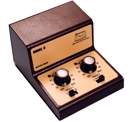 |
||||
| RECENTLY VIEWED |
| PLSWELD - (PPC-2P) Plastic Weld Glue | ||
| ODAP007 - Austin Princess Late Black | ||
| DA7F-042-040 - KFA Flat Wagon VNH-1 Bogies Tiphook Rail 93389 | ||
| AL20005943 - Master 53' CMC Container Set (3) EMP Large Side Logo | ||
| PKET38501-29 - (S) Circuit Board for Battery Pack |
| O Scale | Wargaming | Architectural | Narrow Gauge | Tools+ | ||
A History of Canadian Railways
Part 2: Canadian Pacific 1881 - Present

STUART JORDAN looks at some of the difficulties faced building the first Canadian transcontinental Railway.
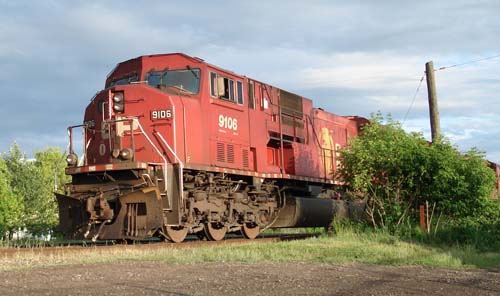
As we saw in the previous article, in 1867 work began on the Intercolonial Railway, which helped cement Canadian Confederation. The Maritime Provinces agreed to join because of the Intercolonial Railway, and British Columbia joined on the promise that a Transcontinental Railway would be built.
The Canadian Pacific Railway Company was incorporated in 1881, and was given a large government grant to build a transcontinental railway across Canada. Work started from Bonville, Ontario the same year, but construction was dogged with several problems on the way.
It was first thought that the railway would take a northerly route across the country, but a southerly route was chosen, close to the US/Canada border to stop competing American railroads. The chosen route would take the railway west across the prairies, and then through the Rocky Mountains at Kicking Horse Pass - named, in the inimitable North American way, for the naturalist James Hector who was kicked by his horse while exploring the region.
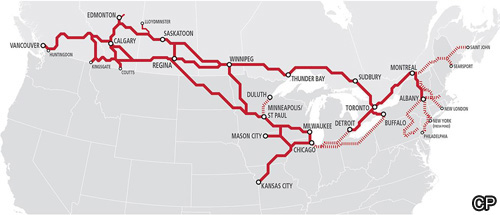
The current Canadian Pacific route map. A more detailed map can be found here (opens in new window).
West of Kicking Horse Pass is Big Hill, where the railway would have to ascend 1,070ft (330m) in just 10 miles (16km). The line had to be built at a 4 ˝ % gradient, which lead to several runaways, including the very first train taken up which ended up in the Kicking Horse River with the loss of three lives. Three spur run-offs were built, and the 4-4-0 locomotives being used were replaced with more powerful 2-8-0 engines from the Baldwin Locomotive Works to work as pushers, and were the most powerful locomotives available in 1884. This route remained in service until the early 20th Century, when two spiral tunnels were built in the valley sides – which opened in 1909.
The proposed route was also planned to cross land in Alberta province belonging to the Blackfoot Indians. Fears of attacks on railway works and stock were allayed when Albert Lacombe, a missionary priest, spoke to the Blackfoot and persuaded them that the coming of the railways was inevitable, and their hostility ended. For this sterling work Lacombe was given a lifetime Canadian Pacific pass.
In 1885 the native Métis people of Saskatchewan rose up against the government of Canada, in a dispute over aboriginal rights that would become known as the North-West Rebellion. Despite the fact that parts of the track were incomplete or untested, the Canadian Pacific moved troops to the area in nine days, and the rebellion was suppressed in two months. This gave the CPR a massive boost in popularity amongst the general public and in the government, who released more funds to help complete the line.
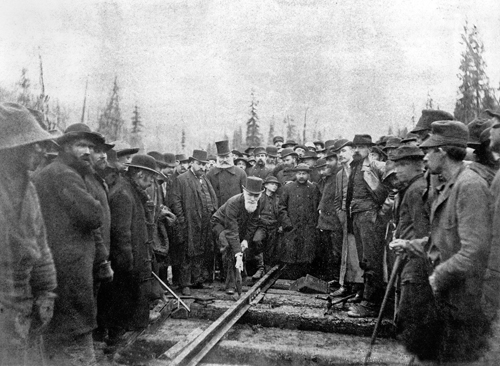
Donald Smith, co-founder of the Canadian Pacific, drives the last spike at Craigllachie.
On the 7th November 1885 the last spike was driven into the track at Craigllachie, British Columbia, completing the transcontinental Canadian Pacific in just four years – an immense feat of engineering considering the trials faced. It was the longest railway in the world at the time.
The first continuous transcontinental passenger train left Dalhousie Station Montreal at 8pm on 28th June 1886, and arrived in Port Moody, Vancouver nearly six days later at noon on 4th July. The CPR quickly became profitable and paid back the many government loans ahead of time .There was mass expansion of the railway between 1886 and 1900 with long term leases bought on smaller lines.
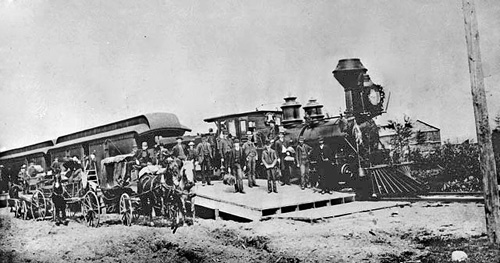
The first CPR transcontinental train, pictured at Port Arthur, Ontario.
Freight travel expanded, with grain in the Prairies and mining in southern British Columbia. The initial contract with the Canadian government gave the CPR 25million acres of land in the Prairies, which CPR used to encourage immigration to Canada. An intense overseas campaign saw agents offering travel on a CP ship, travel on a CP train, and then CP land at $2.50 an acre.
Between 1890 and 1933 raw silk from the Far East was transported by the CPR from ports around Vancouver to mills in New York and New Jersey. Due to the high value of the cargo these trains were given armed guards and priority over other trains on the line.
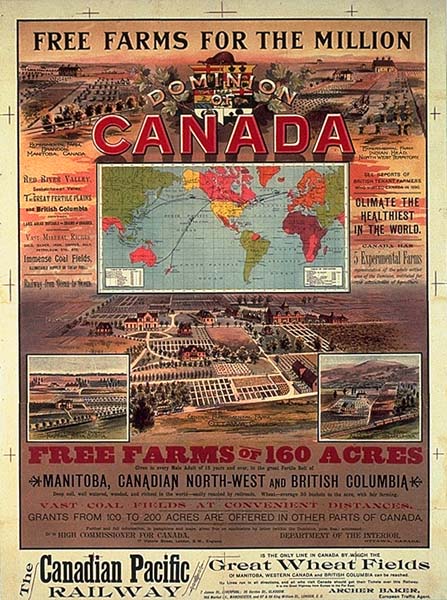
A poster encouraging people to head to the Canadian Prairies to take Canadian Pacific land for farming.
During the First World War the Canadian Pacific was a great boon to the Allied war effort. Its railways, ships, hotels, and telegraphs helped to marshal troops from around the country. At the end of the war the first real competition to the CPR came with the Canadian National in 1918. The Canadian Pacific survived through the Great Depression in the 1920s and 1930s due to it being debt-free. During the Second World War CPR performed the same role as before, as well as producing tanks and other military vehicles for the British and Commonwealth forces.
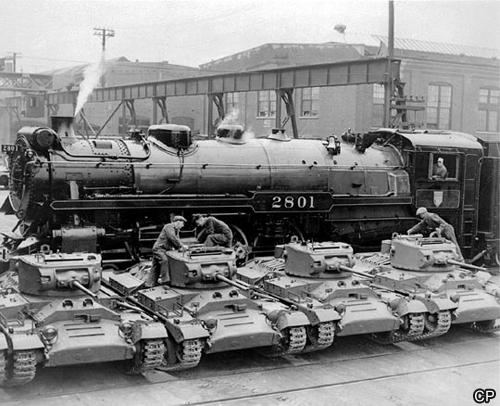
Valantine Tanks built by Canadian Pacific, destined for Russian service.
Post-war, passenger traffic declined. In an attempt to diversify and boost passenger revenue the “Canadian” luxury transcontinental train was introduced. However passenger numbers still fell, and services were transferred to the state-owned VIA Rail company in 1978. Over the next few year the CPR downsized, and several branch lines were sold off or abandoned, including all routes east of Montreal (meaning the line was no longer transcontinental). The knock-on of this was that a large number of grain elevators in the Prairie 'Breadbasket' area closed down, because production was outstripping the distribution capacity. Some freight thrived though, with coal exports from British Columbia now heading back out across the Pacific from the same ports that used to take in silk shipments. Coal, grain, and inter-modal loads still make up the bulk of the CPR freight traffic.
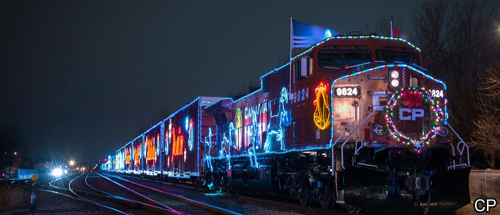
The Canadian Pacific Holiday Train, which travels round Canada and the US at Christmas time raising money for charity.
In the final part of this article we will look at the history of CPR's main rival, the Canadian National.
The following manufacturers produce Canadian Outline stock:
|
We are always looking to make improvements to our website to try and improve the quality of your visit. We would welcome your feedback and suggestions, so please do not hesitate to e-mail our webmaster with your comments. Alternatively call us on 01903 884488.
Home Cookies Privacy Statement Terms & Conditions Site Map Site Guide
WEEE Regulations Glossary Careers & Jobs
Tel – +44 (0) 1903 884488 Fax – +44 (0) 1903 884377 E-Mail us – click here
Gaugemaster.com is a trading name of Gaugemaster Controls Ltd.
Registered in England No. 2714470, Registered office:
Gaugemaster House, Ford Road
Arundel, West Sussex, BN18 0BN, United Kingdom
VAT Reg. No. 587 8089 71
Copyright © 2003-2014 Gaugemaster Controls Ltd. All Rights Reserved.



















